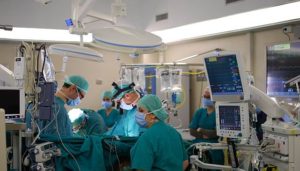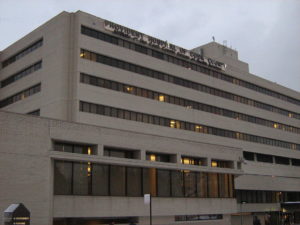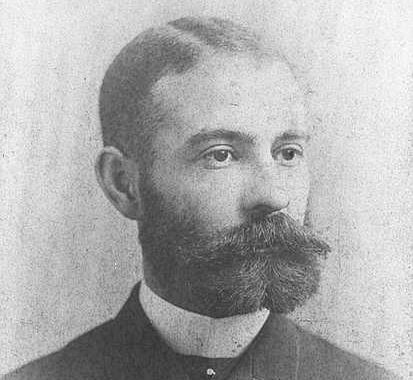Featuring enduring hits like ‘Isn’t She Lovely,’ ‘Sir Duke,’ and ‘As,’ a compelling case could be made that Stevie Wonder’s Songs in the Key of Life is the album he was born to record.
Rolling Stone seems to think so too, naming Wonder’s 1976 funk/soul masterpiece the fourth finest in music history.
“The album’s mastery of many styles remains astonishing, but the feat might not have meant so much had Wonder not delivered some of his most impassioned political art as well … perhaps most movingly, ‘Black Man,’ in which he runs down a funky list of global Afro-diasporic aspirations and heroes,” the magazine wrote, of the record.
Hidden amongst ‘Black Man’s honor roll is one of the most incredible pop culture shoutouts in American medical history.
Dr. Daniel Hale Williams was the surgeon that got the shoutout, having successfully repaired the pericardium of a man stabbed in an 1893 Chicago bar fight.
Though resulting research has confirmed a similar surgery took place in St Louis two years before, Williams certainly deserved Wonder’s attention.
A physician and surgeon at a time when color usually divided his profession and patients, he continually battled against racial injustice, claiming significant victories.
Thanks to Williams—originally a barber—Black nurses were able to train in Chicago for the first time, while the city’s Black med students were finally able to gain residencies they were previously barred from.
“To have known him was a pleasure; to know him intimately was a priceless privilege,” Helen Buckler wrote, in her 1954 biography of Williams.
“He was at once an inspiration and an aid. To emulate his simplicity, his kindly spirit and his great modesty is to pay tribute to the truly great. The world has lost greatly [with his death].”
‘The limit set by nature’
Every day, thousands of different types of heart surgery occur in the United States. Up to 500,000 are believed to take place every year, including 3400 heart transplants.
Though still a nerve-wracking experience for patients, and delicate challenges for those conducting procedures, heart surgeries have become safer—even more routine—as recent decades have provided technological advancements.
“When people think about heart surgery, it is usually the idea of ‘open heart surgery,” Dr. Antony Chu wrote for Lifespan.
“This surgery is considered invasive. It not only includes a large incision in the chest, but, also, the heart is stopped and the patient is put on a heart-lung machine during the procedure.

“In the last two decades, great advances have been made in the field of minimally invasive procedures. Treating the heart is no exception. Minimally invasive procedures involve small incisions, through which surgeons can use a camera and robotic surgical tools that allow for great incision.”
Despite the current state of play, there was a time when physicians getting anywhere near the heart was considered bad practice.
As late as 1896, three years after Williams’ procedure in Chicago, renowned English surgeon Dr. Stephen Paget declared “surgery of the heart has probably reached the limit set by nature to all surgery; no new method and no new discovery can overcome the natural difficulties that attend a wound of the heart.”
Dr. Ludwig Rehn made the first successful repair of a stab wound to the heart itself in Frankfurt, Germany, during the same year Paget scotched further advances. Milestones regularly fell for the next 70 years.
He was at once an inspiration and an aid. To emulate his simplicity, his kindly spirit and his great modesty is to pay tribute to the truly great.
Though he didn’t set out to join its ranks, Williams’ journey into the annals of heart surgery history is perhaps more incredible than many of its other big names.
Born on January 18, 1856 in Hollidaysburg, Pennsylvania, Williams was one of eight children. His father was a deeply religious Black barber, while his mother, Sarah Price, was a mixed-race abolitionist.
Tragedy struck the family in 1865, when his father died of consumption. It forced the Williams family to move to Baltimore, where the future surgeon would become a shoemaker’s apprentice.
Williams moved to Janesville, Wisconsin in his late teens, where, like his father, he was a successful barber. Eventually, he was drawn to medicine and started as an apprentice to Dr. Henry Palmer, a famous Civil War surgeon.
Palmer, later a Surgeon-General of Wisconsin, helped Williams into a spot at Chicago Medical School in 1880. He would graduate from three years later, at the time when only three other Black physicians were practicing in the city.
A bar fight in Chicago
Work at a small South Chicago practice opened Williams’ eyes to the systematic disparities felt by its Black community.
“He treated Black and white patients in his practice, but was aware of limited opportunities for Black physicians,” Marea Donnelly of the Daily Telegraph wrote, in 2018.
In 1890, Williams was approached by the pastor of a local church who told him that his sister had been turned down from all of Chicago’s training programs for nurses, because she was Black.
“The solution was a hospital, not restricted to either race, which would train Black nurses,” Dr. Alisha Jeffeson and Dr. Tamra McKenzie wrote, in 2017.
“[Williams] and other Black physicians would benefit, as it would be an inpatient facility for their patients. Another pressing need would be met: intern training positions for Black medical school graduates.”
Black community leaders pledged Williams funding, while a range of local businesses also provided support. Frederick Douglass, the legendary abolitionist leader, donated proceeds from a guest lecture.
Exploring the wound, Williams found a severed artery. He closed it with sutures, but then discerned an inch-long gash in the pericardium, the tough sac that surrounds the heart.
In May 1891, the Provident Hospital and Training School Association opened its doors, becoming the first Black owned and operated hospital in the United States. Originally a 12-bed facility, a Black delivery worker called James Cornish would fill one two years later.
On July 9, 1893, Cornish was “drinking Scotch and playing cards” at a Chicago bar when things took a bad turn. The 26-year-old was stabbed in the chest during a brawl, and brought into Provident Hospital for care.
The 26-year-old continued to bleed from his chest wound overnight, and was in shock the following morning. With five other surgeons watching on, Williams was forced into action.
“With a scalpel, he cut a small hole in Cornish’s chest,” Ronald Kotulak, a health reporter at the Chicago Tribune, later wrote,” carefully picking his way past nerves, muscle, blood vessels and ribs until he reached the rapidly beating heart.
“Exploring the wound, Williams found a severed artery. He closed it with sutures, but then discerned an inch-long gash in the pericardium, the tough sac that surrounds the heart.
“The heart itself had only been nicked and did not need sutures. But the damaged sac had to be closed. With Cornish’s heart beating 130 times a minute beneath his nimble fingers, Williams closed the wound with catgut.”
Though a two and a half liter pleural effusion created some complications during recovery, Williams was able to release Cornish from Provident seven weeks after his surgery.
The patient would live for another two decades, bumping into Williams one more time, in 1895, while working at the Union Stockyards.
A proud legacy
While Williams believed his pericardium procedure was historic, and reported his efforts as such to the Medical Record in 1897, he missed a paper showing that Dr. Henry C. Dalton, of St Louis, was first in 1891.
Though Williams’ procedure wasn’t the history making—historians and pop legends would remain confused about it for decades to come—it still stands as an important milestone for heart surgery.
While Wonder didn’t have room for the whole resume on ‘Black Man,’ Williams final years certainly cemented his place in Black medical history. He would serve as the professor of surgery at Howard Medical College, surgeon-in-chief at Washington DC’s 220-bed Freedman’s Hospital, as well as holding clinics at Meharry Medical College in Nashville.

Howard and Meharry were the only two Black medical schools left in the U.S by 1910, after the controversial Flexner Report closed 12 others.
Williams also played a key role in establishing the National Medical Association in response to the American Medical Association barring Black doctors. The ground-breaking surgeon died on August 4 1931, in Idlewild, Michigan. He was 75.
Even though that’s nearly a hundred years ago now, and Songs in the Key of Life is now nearly fifty, the iconic surgeon continues to make the needle hit the groove. Recently, Dr. Algeron Edwards, a character on the Cinemax TV show The Knick, was inspired by him.
More importantly, Provident Hospital still remains open today. Despite suffering during the Covid-19 crisis, it is line for $200 million redevelopment in the coming years.
You’d imagine Williams would be just as happy with that news as any hit album reference would make him.
For the record, here it is: Heart surgery / Was first done successfully / By a Black Man.



